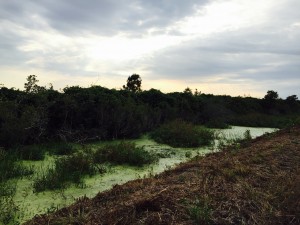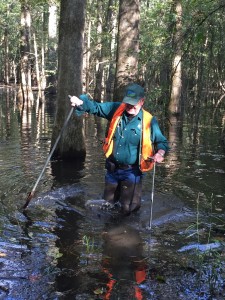What is a trip into the field if you don’t take advantage of all the sensory opportunities that nature has to offer? I went on the Wetlands Ecology & Management field trip to the Outer Banks of North Carolina this October, and I wanted to share a few recollections with you.
No, this is not a description of the lovely places we went or the interesting tidbits I learned about wetlands.
This is about things I ate.
- Peat
Peat is essentially a buildup of organic matter that has decomposed. We explored a type of sandy peat wetland called a “pocosin,” which is only found along the east coast of the U.S., largely in North Carolina.

While in the pocosins, our professor Dr. Curtis Richardson picked up some peat from the ground and invited all of us to touch it. I jumped right on the opportunity and smudged some of the peat between my fingers—it was slimy and glorious.
Dr. Richardson proceeded to suggest that we sample the peat as an appetizer to our seafood dinner. The mucky texture just really didn’t translate into gourmet dining.

- Mineral Soil
I wish I could say that Dr. Richardson suggested we nibble some mineral soil (what some of us more colloquially might describe as “dirt”), but my sampling of this fine delicacy was accidental.
While exiting a wetland toward the road that bordered it, I found that several plants took a liking to my outdoorswoman pants. As we trekked from the middle of this damp, vibrant wetland, I felt the little pricklers grabbing at my pant legs.
Right at the edge of the wetland, I felt a tug and quickly understood that a bramble had grabbed my leg.
The wetland would not let me go.

I fell hard onto my backside, which resulted in a large tear on the seat of my pants.
The commotion stirred up dirt and resulted in the taste of crunchy minerals, metals, and organic materials in my mouth. Delicious.
Dr. Richardson said he thought that was the first time someone ripped their pants on a wetlands field trip.
One could say I’m a trailblazer.
- Sand
Again, the consumption of sand was not an intentional occurrence. Though I’m sure pretty much everyone who’s ever been to a beach can concur that sand finds its way everywhere you don’t want it to.

On the Saturday of our wetlands field trip, we explored the salt marshes near the beaches of the Outer Banks.
It is commonly accepted that when you are on the beach with your friends, you must take pictures. In the middle of this required photo shoot, I jumped up and down with excitement… until I felt my foot seize up in a cramp…

I tumbled onto the beach, completely flat on my face, gripping my foot. My foot recovered itself within a couple of minutes, but it took quite a while to clean the sand out of my hair and mouth.
I love that I have a story of a beach trip gone wrong while on a school field trip. I love studying in the school of environment; we have the most wonderful classrooms!
- Spaghetti… on the floor
Here’s the scene: a bunch of graduate students, their TAs, and their professor, sitting around the living room of a beach house rental, enjoying the family-style spaghetti dinner that they had cooked together.

We were watching football and chatting, when I decided to try to get up from the floor and sit on the footrest of a couch. As I lowered myself down to sit, I felt the footrest give out under me, and I went tumbling (again) to the floor.
There’s something magical about being able to familiarize oneself with a top-notch researcher and professor in such an informal environment.

I think the moral of this long and winding story is that the Nicholas School affords us an unforgettable opportunity to study the environment first-hand. Our connection with the environment is multifaceted and multi-sensory.
We breathe the earth, we gaze at it, we touch the trees and the streams and the grasses in the marshes. We hear crashing ocean waves and the flow of wind through leaves. We taste the berries and greens and sands and spaghettis of the earth.
We are all swamp people. We are all mountain people. We are all the ocean and the peat and the stream.
“The river is within us, the sea is all about us;/ The sea is the land’s edge also, the granite,/ Into which it reaches, the beaches where it tosses/ Its hints of earlier and other creation:” – T.S. Eliot, “Four Quartets”

Meagan, your grace and poise inspire us all. Thank you for sharing your well-balanced tastes.